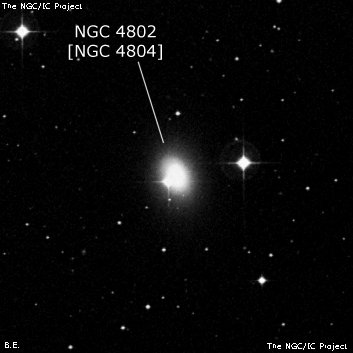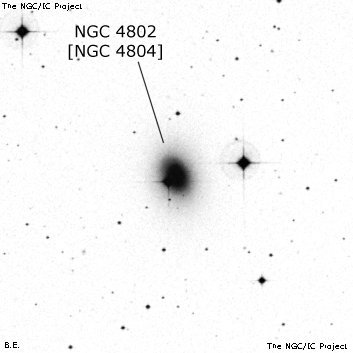NGC/IC Project Restoration Effort
(This is a very very beta version)
NGC4802


Basic Information
Location and Magnitude
Right Ascension: 12:55:49.6
Declination: -12:3:17
Constellation: CRV
Visual Magnitude: 11.4
Historic Information
Discoverer: Tempel
Year of discovery: 1882
Discovery aperture: 11.0
Observational
Summary description: vF, S, * 10 att
Sub-type: S0
Corwin's Notes
=====
NGC 4802 is most likely also NGC 4804. But that is not absolutely certain.
Here is the story.
N4802 is just where Tempel placed it in his observation of 20 April 1882.
Herbert Howe, however, says "This was searched for in vain one night. Its
description is so similar to that of 4804 that they may be identical, if the
declination of 4802 is just 1 degree in error."
Dreyer adds to this in an IC2 Note, "Tempel says it is 8 seconds following
Lamont 1234 (10 mag), but this identification may be wrong." I have not yet
been able to find the Lamont list, but Tempel's observation, as I said, is
exactly right: the galaxy is just where he measured it to be, and his
description is apt, so I have no reason to doubt his identification of the
star.
So, I wonder if Howe somehow confused N4802 with N4804 -- the latter
galaxy is NOT in its nominal position. It was found by WH on 27 Mar 1786 in
Sweep 548. His published list has it 30m 45s preceding and 18 arcmin south of
68 Virginis. Checking the Herschel Archives, however, shows that these
offsets were calculated later from times and north polar distances recorded
during the sweep. If WH's recorded north polar distance was 100 deg 56 min
rather than 101 deg 56 min as in CH's copy of the sweeps, then the calculated
offset would become 42 arcmin north of 68 Virginis, and the object is
certainly the same one Tempel saw.
However, WH's description reads, "Suspected a pB star, with a seeming brush to
the np may be a small nebula close to it, but there was no time to verify it."
Just about an arcminute north of WH's position is a double star whose
orientation is northwest-southeast, and whose components have virtually
identical magnitudes (13.85 in GSC; probably around 13.3 or 13.4 in V,
depending on the stars' colors). It is just possible that WH saw the double
star and in his hurry, mistook it for a star and a nebula. Also arguing for
taking WH's 101 degrees at face value is the fact that none of the other
nebulae that he found during the sweep have serious errors in their positions
(these are NGC 4714, 4748, 4782/83, 4794, 4825, and 5094).
I think it's more likely, though, that he simply made a 1-degree error in his
north polar distance. This would, of course, explain Bigourdan's not finding
the object at the NGC position; Dreyer mentioned this negative observation in
his Notes in the Scientific Papers.
So, in the end, the most likely explanation is that WH saw the same object
that Tempel did nearly a century later. But given the double star, I've kept
the colons, just in case.
Steve's Notes
=====
NGC 4802
17.5" (3/23/85): fairly faint, very small, weak concentration to a virtually stellar nucleus. A mag 11 star is just off the SE edge. Located 30' NE of the NGC 4782/NGC 4783 pair.



